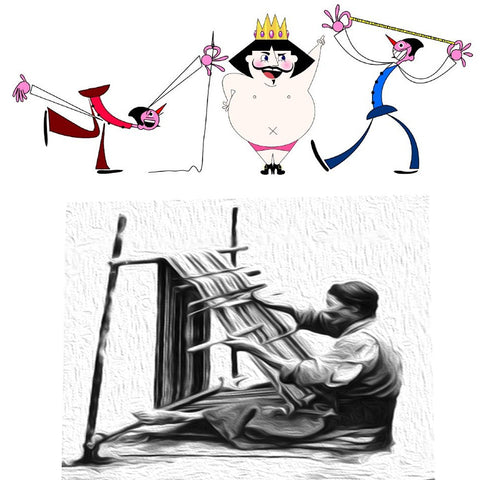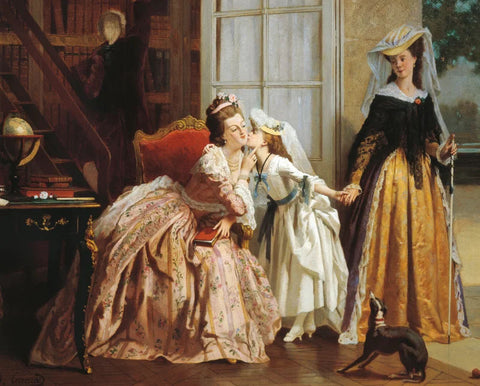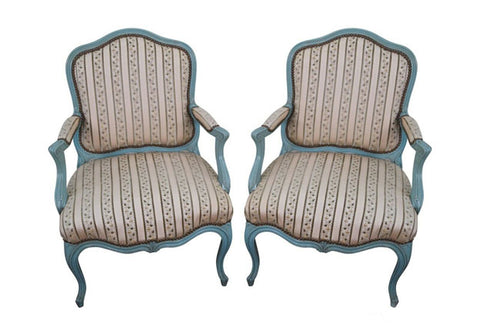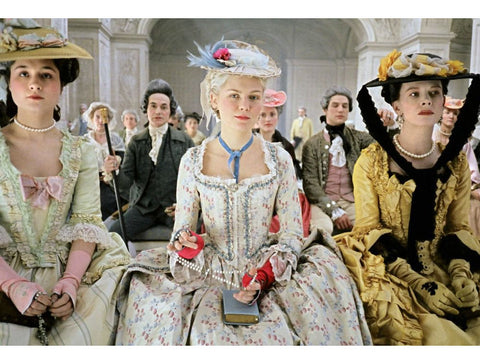Once Upon a Time...
many years ago in France, there was a Fabric so excessively fond of being elegant that weavers spent hours and hours creating it. The most delicate silk, gold thread, and rich colors were used to create exquisite patterns.

The French coined this weaving technique Liseré. As in the classic fairy tale by Hans Christian Anderson, The Emperor's New Clothes, only the royal family could afford these textiles, which made the finest suites for men and the most exquisite detailed dresses for women.

However, unlike the emperor in Anderson's fairy tale, a true queen of the 17th century, Marie Antoinette, actually got to wear such beautiful clothes made by weavers, who created the finest silk cloth with the French Liseré technique.

A picture of Antoinette with her daughter, wearing a dress with a Liseré pattern.
Historians report that in May 1770, at the age of 14, Antoinette set out for France to be married to Louie XVI, escorted by 57 carriages, 117 footmen, and 376 horses. History shows that her story did not end well ... however, neither did the emperors!
It’s All in the Hands
Before the 18th century, the manufacture of cloth was done by hand. Weavers would take the thread and loop it back and forth over a loom to make the warp, and then weave back and forth through the warp to make the weft. Voila! Simple? No, it took weeks to just make the cloth ... never mind a dress.
The Very Industrious Revolution
In the mid-18th century, artisans became more productive with weaving cloth. Simple machines were used and perfected. Eventually, silk, wool, and linen were eclipsed by cotton, which became the most widely used fabric. We still use the Liseré technique today. Martin Ciszuk from Duran Textiles explained that the silk thread is woven with a white warp and two wefts. The two wefts alternate and float on the face side in the pattern; the warp-faced structure of the background are bound on the reverse side.

Not Just for Clothes Anymore
The story of Liseré fabric has continued through many centuries and is now represented in today's home decor marketplace, by Brunschwig and Fils Fabric. Not sure anyone would want a tank top or a pair of shorts with a Liseré pattern anyway! So, the home décor market grabbed the concept, and still, after hundreds of years, Lisere' remains timeless.

Antique French Louis XV Style of Painted Chairs from Bucks County Estate Trader
It's Movie Time!
Grab a comfy wing back chair covered in your favorite Liseré fabric from Brunswchig and Fils. Kick back and watch the movie Marie Antoinette, directed by Sofia Coppola, starring Kirsten Dunst. Based on the life of Queen Marie Antoinette in the years leading up to the French Revolution, the film won the Academy Award for Best Costume Design (Released on October 20, 2006, by Columbia Pictures)

The costumes were designed by Academy Award winner Milena Canonero, who used Liseré patterns and beautiful fabric designs that told the movie through her costumes.


Leave a Comment